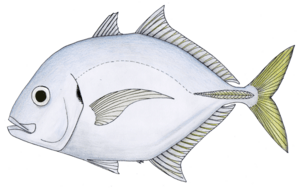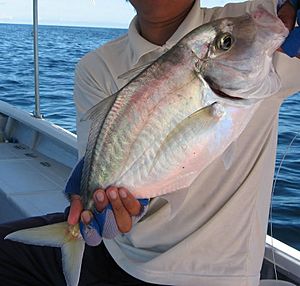Imposter trevally facts for kids
Quick facts for kids Imposter trevally |
|
|---|---|
 |
|
| Conservation status | |
| Scientific classification | |
 |
|
| Approximate range of the imposter trevally | |
| Synonyms | |
|
The imposter trevally (Carangoides talamparoides) is a small ocean fish. It's also known as the imposter jack or white-tongued trevally. This fish belongs to the jack family, called Carangidae. You can find the imposter trevally in warm, tropical waters. It lives in parts of the Indian Ocean and the western Pacific Ocean.
Its home stretches from the Gulf of Oman all the way to Japan and Australia. This fish looks a lot like the Malabar trevally. But you can tell them apart by counting their gill rakers. A special feature of the imposter trevally is its white or pale grey tongue. It's a fairly small fish, usually growing up to 30 cm long. The imposter trevally lives in coastal waters. It can be found on the continental shelf up to 140 meters deep. These fish often hang out with other similar jack species. They eat small fish, crustaceans, and cephalopods. The imposter trevally is not a major fishing target. People catch it with hooks, lines, and nets.
Contents
About the Imposter Trevally
The imposter trevally is part of the Carangoides group. This group includes many types of fish known as jacks and trevallies. All these fish are part of the larger Carangidae family. The Carangidae family belongs to the order called Carangiformes.
How the Imposter Trevally Got Its Name
A Dutch scientist named Pieter Bleeker first described this fish in 1852. He studied a fish specimen found in western Sumatra, Indonesia. Bleeker named the new species Carangoides talamparoides. The name talamparoides is a bit tricky. "Talam" is an old measurement, and "par" means 'equal' in Greek. "Oides" means 'like'. This name might hint at the small size of the fish he studied. Scientists still use Bleeker's original name today. Only one other name, Carangoides gibber, was used for a short time.
What Does the Imposter Trevally Look Like?
The imposter trevally is a small fish. It grows to about 30 cm long. This is small compared to many of its relatives. Its body shape is similar to other Carangoides fish. It has a flat, oval-shaped body. The top part of its body is a bit more curved than the bottom. This is because its head slopes up sharply to its neck area.
Fins and Scales
The fish has two main dorsal fins on its back. The first one has 8 stiff spines. The second one has 1 spine and 20 to 23 soft rays. The anal fin on its belly has two separate spines in front. The main part of this fin has 1 spine and 17 to 19 soft rays. The tips of the soft dorsal and anal fins are short.
The lateral line on its side has a gentle curve at the front. This curved part is much longer than the straight part. The lateral line has 32 to 52 scales. About 20 to 32 of these are weak scutes near its tail fin. The area under its throat and belly has no scales. This bare area goes past its pelvic fins and sometimes reaches its anal fin. It also extends up to the base of its pectoral fins.
Teeth and Gills
Both the upper and lower jaws have rows of tiny, brush-like teeth. Some of the outer teeth at the front of its mouth are cone-shaped. The imposter trevally has 27 to 31 gill rakers. These are small, bony parts that help the fish filter food from the water. It also has 24 vertebrae (backbones).
Color and Special Features
The imposter trevally is silver to bluish-grey on its back. Its belly is silvery-white. A key way to identify this fish is its white to pale grey tongue. This is a unique feature. It also has a small black spot on the upper edge of its gill cover. The soft dorsal and anal fins are dark. The tail fin is dusky yellow with black edges.
Where the Imposter Trevally Lives
The imposter trevally lives in the warm, tropical waters of the Indian Ocean and the western Pacific Ocean. Its home range starts in the Gulf of Oman. It then stretches across to India and Sri Lanka. There's a gap in records between Sri Lanka and the Gulf of Thailand.
In the western Pacific, you can find the imposter trevally in Southeast Asian waters. This includes the Gulf of Thailand, Sumatra, and Borneo. It also lives further east, near the Philippines and Guam. Its range extends south to Australia.
Habitat
The imposter trevally prefers coastal waters. It is often found over sandy areas on the continental shelf. For example, off North West Australia, it lives in waters 30 to 140 meters deep. It is known to share its home with other trevally species. These include the Coastal trevally (Carangoides coeruleopinnatus) and Carangoides malabaricus.
Life and Diet of the Imposter Trevally
Scientists have studied what the imposter trevally eats. One study in Australia found that small teleost fish make up most of its diet (73%). Cephalopods, like squid, are another important food source (16%). The rest of its diet includes different types of crustaceans. These can be crabs and mantis shrimp. It's thought that the imposter trevally and its relatives share food resources. This allows them to live together without competing too much. We don't know much about how this fish reproduces or how fast it grows.
Fishing for Imposter Trevally
The imposter trevally is not a very important fish for commercial fisheries. It is sometimes caught by people using hooks and lines. It can also be caught in bottom trawls and various types of traditional nets. In northern Australia, it's often caught by accident in prawn trawlers. When this happens, it's usually thrown back into the ocean.
See also
 In Spanish: Carangoides talamparoides para niños
In Spanish: Carangoides talamparoides para niños



